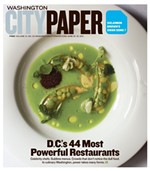The Terror of History
It’s probably fair to suggest that both Eli Roth and Zombi would be nothing without the ’70s. It’s probably fair, even, to suggest that both the director of Hostel and the instrumental-rock duo from Chicago by way of Pittsburgh would be nothing without a very specific part of the ’70s: grindhouse cinema. The band took its name from hometown hero George A. Romero’s Dawn of the Dead, a rampaging-cannibal flick that was rechristened Zombi for its Italian release in 1978. And according to keyboardist/bassist Steve Moore, the band drew its initial musical inspiration from Goblin, the Italian prog act that recorded the soundtrack for Zombi as well as many of Romero collaborator Dario Argento’s best-known films, such as 1975’s Profundo Rosso and 1977’s Suspiria.
Still, Zombi is nobody’s tribute act. The duo’s first widely available full-length, 2004’s Cosmos, was, it’s true, strongly reminiscent of Goblin at its creepy-groovy peak—a period that, despite the band’s outsized legend, lasted for only a couple of movies. But Cosmos incorporated other fright-flick sounds, too. For starters, there was the Transylvanian minimalism of Mike Oldfield’s Tubular Bells, music used to infamous effect in The Exorcist. There was also the slaughterhouse pop of Fabio Frizzi’s synth scores, the grimmest—and therefore best—of which is the soundtrack to Zombi 2, Lucio Fulci’s sequel to, yes, Zombi. Obsessed? Yes. But not single-minded: On Cosmos, Moore and drummer/keyboardist A.E. Paterra embraced the idea of ’70s-horror-movie music, not any one band or composer.
New full-length Surface to Air, by contrast, is much less of a soundtrack in search of a film. If Cosmos suggests Moore and Paterra jamming in front of looped dailies, then Surface summons imagery of the band sweating it out in someone’s garage, trying to make music that stands on its own. Perhaps the best example of this is “Night Rhythms,” Surface’s multisectioned finale. Whereas Cosmos’ tunes tend to revolve around a single motif—and rarely last longer than it would take to disembowel a horny teenager—this track packs a decade’s worth of progressive rock into its 18-minute running time. It’s the stuff of tangerine dreams—not to mention topographic oceans, pawn hearts, and the rest of it.
That’s not to say Surface abandons Cosmos’ don’t-go-in-the-basement vibe, which is the essence of Zombi’s appeal. There’s plenty of sonic dread on the new disc—plenty of heart-quickening beats and hockey-mask synth. The main difference between Surface and what came before it is that the songwriting, while not exactly songwriterly per se, allows the band time to do exactly what a good ’70s horror flick does: build suspense. “Challenger Deep,” the two-movement opener, divides Zombi’s aesthetic into bass-heavy postpunk and racing-scene-street funk. And the title track breaks up the usual electronic swirl with some honest-to-goodness devil’s music: Its chorus screams Sabbath Bloody Sabbath, inasmuch as a keyboard riff can scream anything.
Moore claims that he and Paterra curtailed the kitsch this time around, which may be his way of distancing himself from what he perceives as the borrowed zeitgeist of Roth, The Hills Have Eyes remake man Alexandre Aja, and the rest of the neo-horror crowd. Perhaps he should listen to Wes Craven: In a recent Newsweek, the man who made the original 1977 version of The Hills Have Eyes suggests that the War on Terror is feeding new-millennium horror in much the same way that ’Nam fed the genre back in the day—a phenomenon that horror theoretician Robin Wood has called the “return of the repressed.”
Surface’s title may or may not be a response to 9/11-related warfare, but its music definitely betrays a desire to play in the present tense. The album’s not as much fun as Cosmos, that’s for sure. Yet whatever it sacrifices in terms of grainy-film-stock nostalgia, it more than makes up for with invention and engagement with the world outside of the cinema. It’s probably fair to suggest that any record that draws its most tuneful cut from a Brubeck-gone-bad chord progression has something distinctive to say about music history. And if Craven is right, it’s probably fair to suggest that Surface to Air has something distinctive to say about history history, as well.





